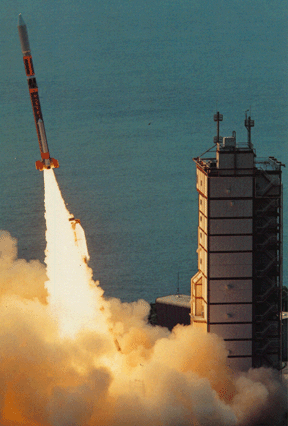The Yohkoh Space Observatory
The Yohkoh satellite , an observatory for studying X-rays
and gamma-rays from the Sun, was launched from Kagoshima, Japan (picture at right) on
August 30, 1991.
Yohkoh is a project of the
Institute for Space and Astronautical Sciences, Japan;
Yohkoh (the spacecraft) was built in Japan, but the observing instruments have
contributions from the United States and from the United Kingdom.
Movie of Yohkoh satellite launch and initial observations
Why should the Sun make X-rays and gamma-rays? The
visible surface of the Sun is hot - some 6,000 degrees, but that is not hot enough
for X-radiation.
The photosphere actually appears dark in the Yohkoh soft X-ray images,
which show instead the extremely hot corona that envelops the Sun and extends far
out into space.
Yohkoh's main scientific objectives deal with finding explanations for the solar X-ray
and gamma-ray emission and the interesting phenomena seen only in this kind of radiation.
|

| | The Mu-3SII rocket sending Yohkoh into orbit.
The launch site is at the southern tip of Japan's southernmost main island, Kyushu,
at the village of Uchinoura on the Ohsumi peninsula.
The Pacific Ocean can be seen in the background.
|
|


